
Nelson Science Perspectives 10
1st Edition
ISBN: 9780176355289
Textbook solutions
All Solutions
Section 13-3: Images in Lenses
Exercise 1
Solution 1
Solution 2
Step 1
1 of 2
$textit{a.}$, Image formed by a converging lens is always real and inverted image of the actual object and is placed beyond $2F$, at $2F$ and between $2F$ and $F$.
Size and location depend of the location of the actual object in front of the lens.
When the object is placed inside the focal length of the lens image is virtual and upward.
$textit{b.}$, Image formed by diverging lens is always virtual and upright, also it is smaller than the actual object.
Result
2 of 2
$textit{a.}$, Image can be: real, inverted, size can vary, and it can be virtual and upward if the object is placed inside the focal length.
$textit{b.}$, Image is: virtual, upright and smaller than the actual object.
Step 1
1 of 3
a. A converging lens always forms a real and inverted image of an object placed beyond 2F, at 2F and between 2F and F. The size and location of these real images varies with the location of the object in front of the lens. A converging lens only forms a virtual and upright image if the object is placed inside the focal length of the lens.
Step 2
2 of 3
b. A diverging lens “always” forms a virtual and upright image of an object placed in front of it. This image is always smaller than the actual object.
Result
3 of 3
Click to see answers.
Exercise 2
Step 1
1 of 8
i. Ray diagram.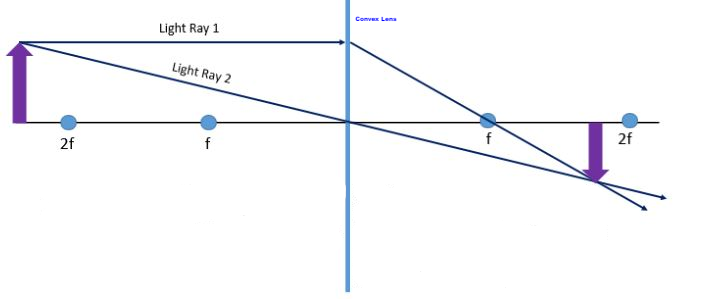

Step 2
2 of 8
The image is real in nature and inverted in attitude. It is smaller than the object and located between F and 2F on the other side of the lens as the object.
Step 3
3 of 8
ii. Ray diagram.
Step 4
4 of 8
The image is real in nature and inverted in attitude. It is larger than the object and located beyond 2F on the other side of the lens as the object.
Step 5
5 of 8
iii. Ray diagram.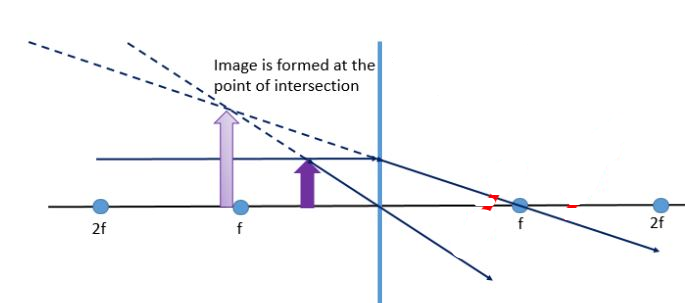

Step 6
6 of 8
The image is virtual in nature and upright in attitude. It is larger than the object and located on the same side of the lens as the object.
Step 7
7 of 8
iv. Ray diagram: Object purple, image blue.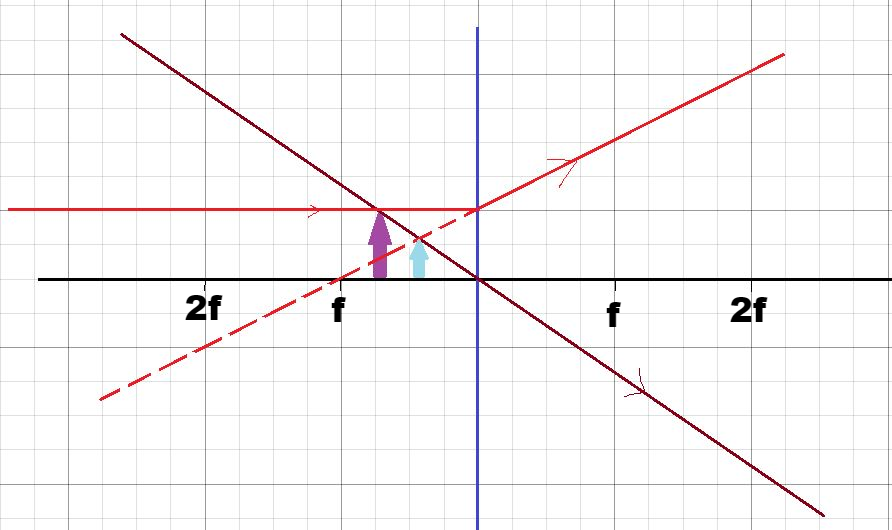

Step 8
8 of 8
The image is virtual in nature and upright in attitude. It is smaller than the object and located on the same side of the lens as the object.
Exercise 3
Step 1
1 of 2
Ray diagram: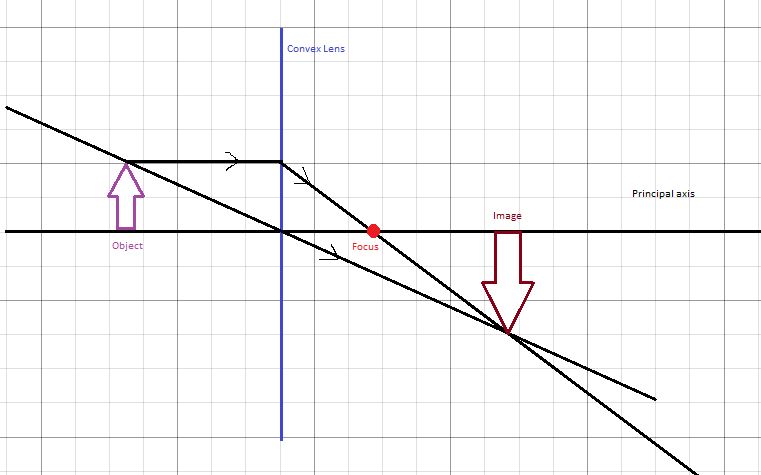
Step 2
2 of 2
First ray 1 is drawn passing from the top of the object and passing via the center of the lens and the top of the image. Then ray 2 parallel to the principal axis is drawn. On refraction it should pass the principal axis and the top of the image. This refracted ray is drawn. The 2 rays should meet on the top of the image. This proves that the ray diagram is accurate as required. The point of intersection of refracted ray 2 and the principal axis is marked. This is the focus of this convex lens.
Exercise 4
Step 1
1 of 4
$textit{a.}$
Ray diagram in the case where half of the lens is covered by the screen:
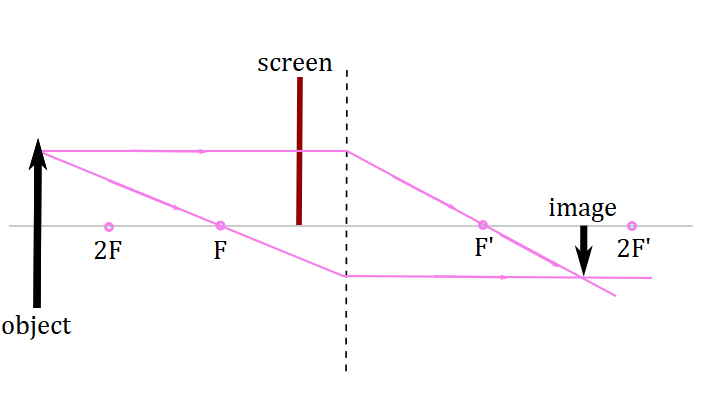
Step 2
2 of 4
When half of the lens is covered, image will get dimmer since will lose half of the light from every part of the object.
Step 3
3 of 4
$textit{b.}$
Ray diagram in the case where half of the object is covered by the screen:
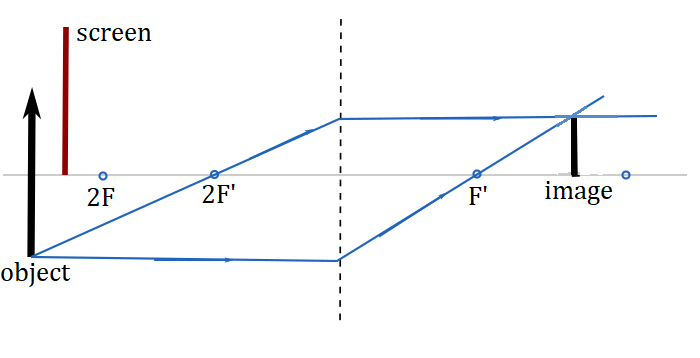
Step 4
4 of 4
When half of the object is covered with screen image of the one half that is not covered will appear.
Exercise 5
Solution 1
Solution 2
Step 1
1 of 2
In the case of diverging lens, real image is never produced since the rays of light always diverge after the reflection, therefore, the image is formed from the converging extensions of these rays.
Result
2 of 2
It cannot be produced since the rays of light always diverge after the reflection.
Step 1
1 of 1
A diverging lens is incapable of producing a real image because its focus itself is virtual. This is because light rays seem to diverge from the opposite side of the lens that has the focus. These diverging rays will therefore never intersect to form a real image.
Exercise 6
Solution 1
Solution 2
Step 1
1 of 1
Virtual images formed by a converging lens are always magnified and larger in size than the object. It is for this reason that converging lens are used as magnifying glasses. Virtual images formed by a diverging lens are, however, always smaller in size than the object.
Step 1
1 of 2
Virtual images which are formed by a converging lens are always magnified and larger in size than the actual object and virtual images formed by a diverging lens are always smaller in size than the actual object.
Result
2 of 2
Virtual images which are formed by a converging lens are always magnified and larger in size than the actual object and virtual images formed by a diverging lens are always smaller in size than the actual object.
Exercise 7
Solution 1
Solution 2
Step 1
1 of 2
Real images are always inverted and on the other side of the lens and virtual images are always upright and on the same side of the lens as the actual object which does not depend on the type of lenses.
Result
2 of 2
Real images: inverted, on the other side of the lens
Virtual images: upright and on the same side of the lens as the actual object.
Result
1 of 1
Independent of the type of lens used, real images are always inverted and on the other side of the lens as the object while virtual images are always upright and on the same side of the lens as the object.
Exercise 8
Step 1
1 of 4
$textit{a.}$, Converging lens is being used in the projector
Step 2
2 of 4
$textit{b.}$ Ray diagram
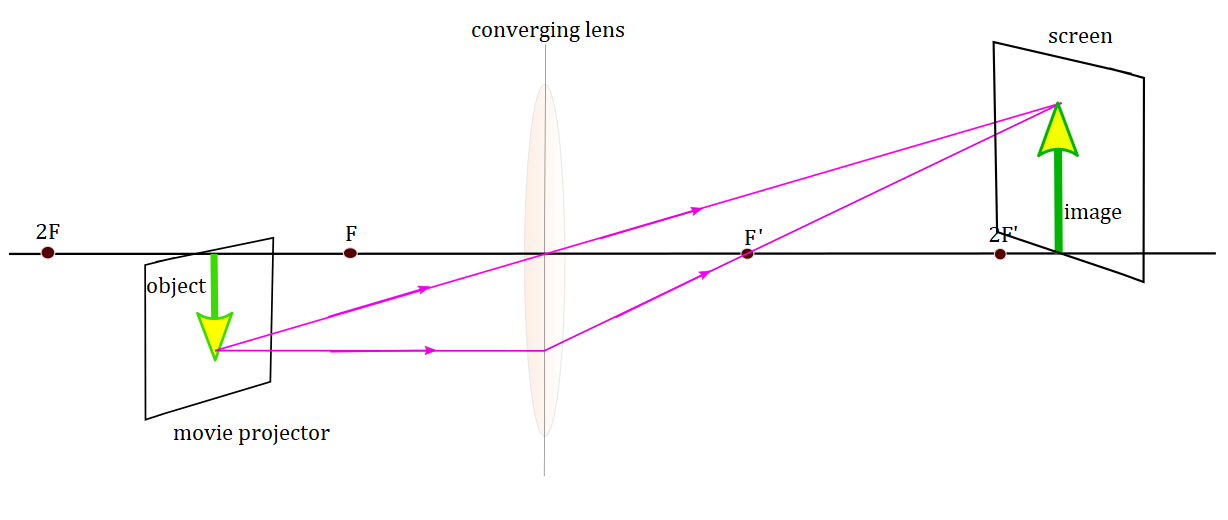
Step 3
3 of 4
$textit{c.}$, Since the “object” which is an image in projector is upside-down on purpose, and being changed while the ray lights pass through the converging, image will be real, inverted (which is upright for the observer), and bigger size.
Result
4 of 4
$textit{a.}$, Converging lens is being used
$textit{c.}$, Image is: real, inverted and bigger size
unlock

